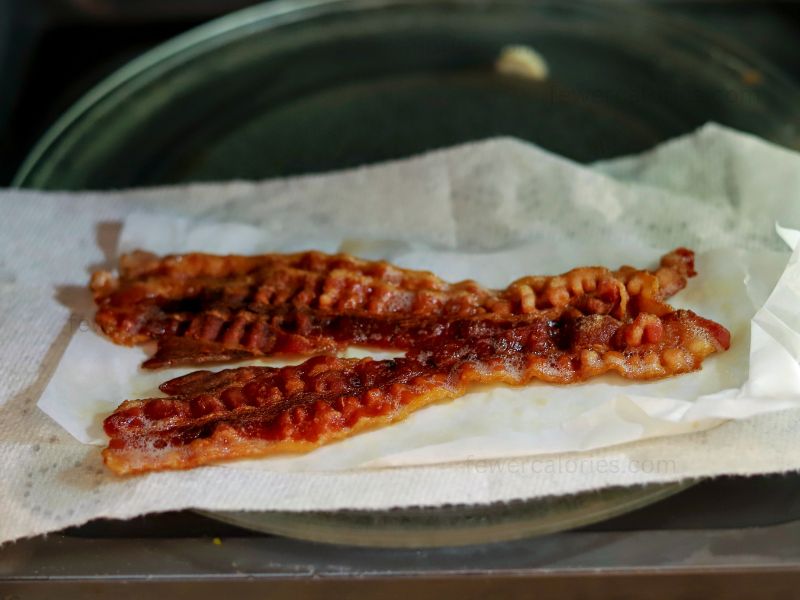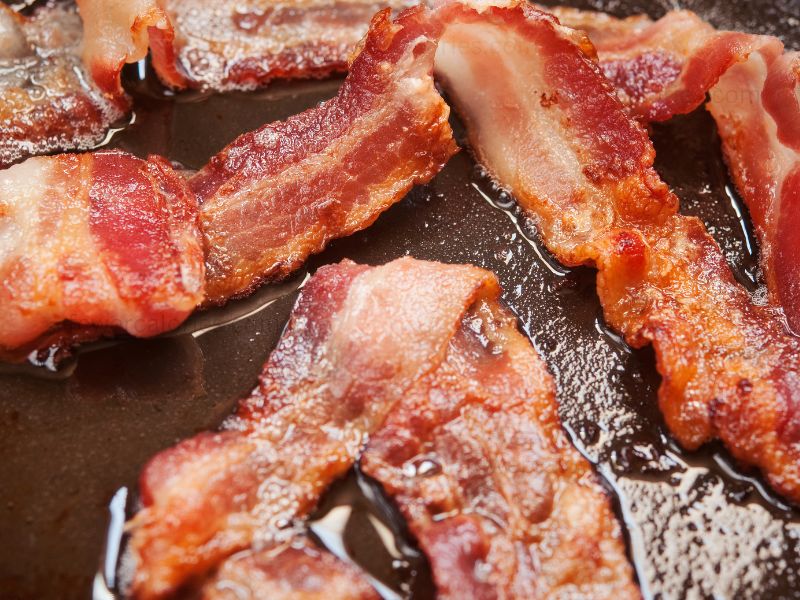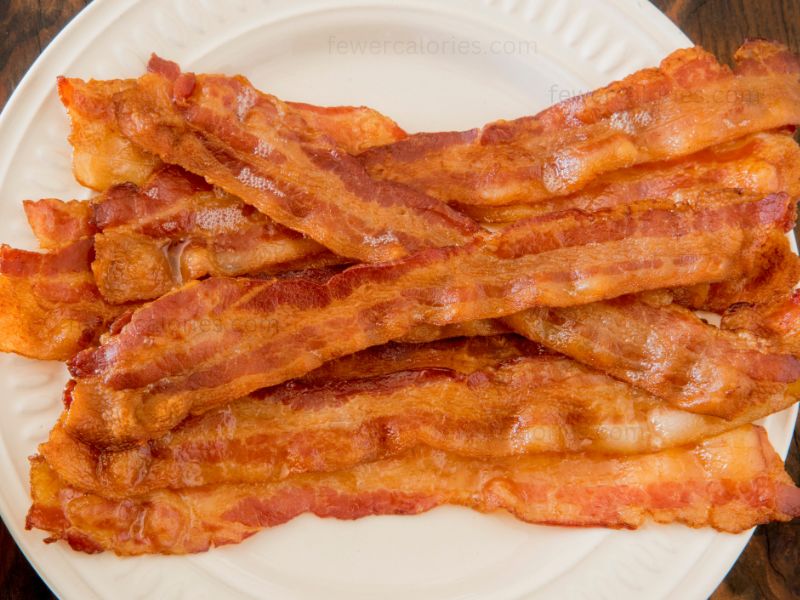The Calorie Conundrum: Microwave vs. Pan-Fried Bacon
You might be wondering whether cooking bacon in the microwave has fewer calories than pan-frying it. This question has sparked debates among bacon lovers and health-conscious individuals alike. In this comprehensive article, we will explore the differences between microwave and pan-fried bacon, analyze the calorie content, and provide insights on cooking methods that may affect the nutritional value.
A Brief Overview of Bacon
Bacon is a beloved food item made from the pork belly or back cuts, which are typically cured, smoked, and sliced. It’s known for its savory taste, crispy texture, and enticing aroma. Bacon is often consumed as a breakfast staple or used as an ingredient in various dishes, such as sandwiches, salads, and pasta. However, bacon has a reputation for being high in calories, fat, and sodium, which can be a concern for those monitoring their diets.
Understanding the Cooking Process
Before diving into the calorie comparison, let’s understand the cooking process of bacon in both methods.
Microwave Cooking
Cooking bacon in the microwave involves placing it on a microwave-safe plate or tray, often lined with paper towels to absorb excess grease. The microwave’s heat causes the bacon’s fat to render, cooking the meat evenly and quickly. Depending on the wattage of your microwave and the desired crispiness, cooking times may vary from three to six minutes.

Pan-Frying
Pan-frying bacon involves placing it in a hot pan, typically without added oil, as the bacon will release its own fat during the cooking process. The bacon is cooked over medium heat, allowing the fat to render slowly and the meat to crisp up. Cooking times may vary depending on the thickness of the bacon and the desired level of crispiness, usually taking about 10 to 15 minutes.
Calorie Comparison: Microwave vs. Pan-Fried Bacon
A crucial factor that affects the calorie content of bacon is the amount of fat it retains after cooking. Since microwaving and pan-frying methods differ in how they cook and render fat from bacon, the calorie content may vary as well.
Microwave Cooking: The Lower Calorie Option
Microwaving bacon tends to result in less fat retention. The paper towels used when microwaving help to absorb excess grease, effectively reducing the amount of fat that remains on the cooked bacon. As a result, microwave-cooked bacon often has fewer calories than its pan-fried counterpart.
For example, a 28-gram serving of cooked microwave bacon contains approximately 45 calories and 3 grams of fat, while the same amount of pan-fried bacon has around 70 calories and 6 grams of fat. That’s a significant difference of 25 calories and 3 grams of fat per serving.
Pan-Frying: The Higher Calorie Option
Pan-frying bacon typically results in higher fat retention, as the bacon continues to cook in its own grease. While you can blot excess fat with paper towels after pan-frying, the bacon will still retain more fat compared to microwaving. Hence, pan-fried bacon generally has a higher calorie content.
Other Factors to Consider
It’s essential to note that other factors can influence the calorie content of cooked bacon. These factors include the cut, thickness, and brand of bacon, as well as individual cooking preferences.
Cut and Thickness
The cut of bacon can affect its calorie content, as different cuts contain varying amounts of fat. For instance, pork belly bacon has more fat than back bacon, resulting in higher calories. Additionally, the thickness of the bacon can influence cooking time and fat rendering, potentially impacting the overall calorie content. Thicker slices may retain more fat and calories compared to thinner ones, regardless of the cooking method.
Brand and Quality
The brand and quality of bacon can also influence its calorie content. Some brands offer leaner cuts, reduced-sodium options, or even uncured varieties, which may have different nutritional profiles. Always check the packaging and nutritional labels to understand the specific calorie and fat content of the bacon you’re purchasing.
let’s talk about some brands that offer various cuts and thicknesses of bacon.
Oscar Mayer is a big name in the United States. They’ve got different cuts and thicknesses in their lineup. You’ll find traditional sliced bacon, center-cut bacon, and thick-cut bacon. They even have turkey bacon if you’re looking for a leaner option.
Now, Smithfield is another popular choice. They offer thick-cut bacon, applewood-smoked bacon, and cherrywood-smoked bacon, to name a few. Their Hometown Original bacon is known for consistent thickness and even slices.
Wright Brand is all about thick-cut, naturally smoked bacon. Their options include applewood-smoked, hickory-smoked, and maple-flavored bacon. You’ll also find ends and pieces, which are irregularly shaped but still packed with flavor.
Applegate Naturals focuses on natural and organic meats, including bacon. Their lineup features uncured Sunday bacon, a medium-thickness cut, and thick-cut uncured bacon. If you’re looking for something leaner, they also offer turkey bacon and Canadian bacon.
Nueske’s is a premium brand with a reputation for applewood-smoked bacon. Both thin and thick cuts are available. And if you like a little spice, they’ve got a peppered bacon variety too.
Lastly, Hormel Black Label has a range of bacon products. You’ll find thick-cut bacon, center-cut bacon, and lower-sodium bacon. Flavored options include applewood-smoked, cherrywood-smoked, and pecan wood-smoked bacon.
So, these brands offer a variety of cuts and thicknesses. But remember to check the packaging for nutrition info. Calorie and fat content can vary depending on the cut, thickness, and flavor.
Cooking Preferences
Individual preferences for bacon crispiness can also impact calorie content. Cooking bacon for a longer time, whether in the microwave or pan, can render more fat and reduce calories. However, overcooking can also result in a less palatable texture and potentially create harmful compounds, such as acrylamide, which form when certain foods are cooked at high temperatures.

Healthier Alternatives
While microwaving bacon does offer a lower-calorie option compared to pan-frying, there are other methods to consider for a healthier bacon experience:
- Baking in the Oven
Baking bacon on a wire rack in the oven allows the fat to drip away from the meat while cooking, reducing the overall calorie and fat content. This method also provides uniform crispiness and can be an excellent choice for cooking larger quantities of bacon.
- Using a Bacon Press
When pan-frying, using a bacon press can help to press out excess fat, resulting in leaner cooked bacon. A bacon press is a flat, heavy object, typically made of cast iron or another heat-conductive material, that is placed on top of the bacon during cooking.
- Opting for Leaner Cuts
Choosing leaner cuts of bacon, such as Canadian bacon or turkey bacon, can provide a lower-calorie alternative to traditional pork belly bacon. These cuts typically have less fat and calories but still offer a satisfying bacon flavor.
In Summary
Microwave-cooked bacon generally contains fewer calories than pan-fried bacon due to the reduced fat retention during the cooking process. However, it’s essential to consider factors such as the bacon cut, thickness, brand, and individual cooking preferences when determining the exact calorie content. Exploring alternative cooking methods and opting for leaner cuts can also contribute to a healthier bacon experience.
© 2012-2023 by LiVentures. All rights reserved. No part of this document may be reproduced or transmitted in any form or by any means, electronic, mechanical, photocopying, recording, or otherwise, without prior written permission of LiVentures.






